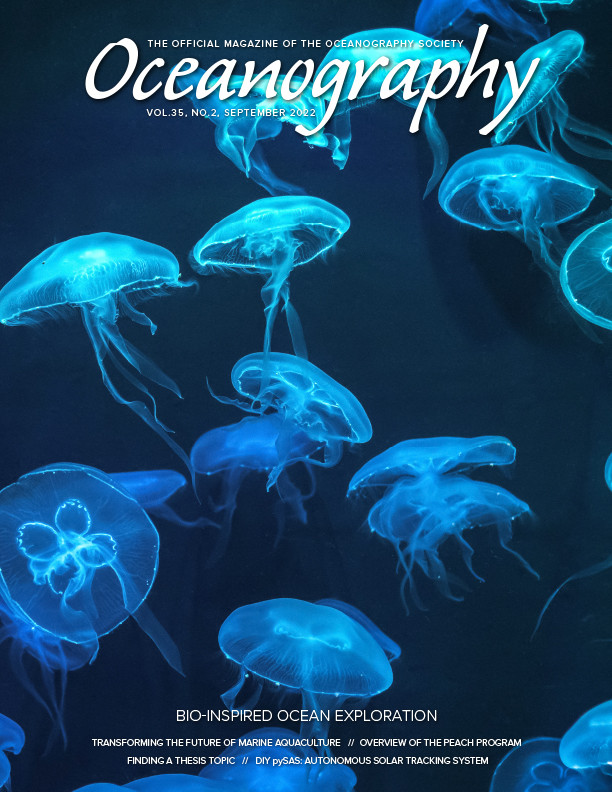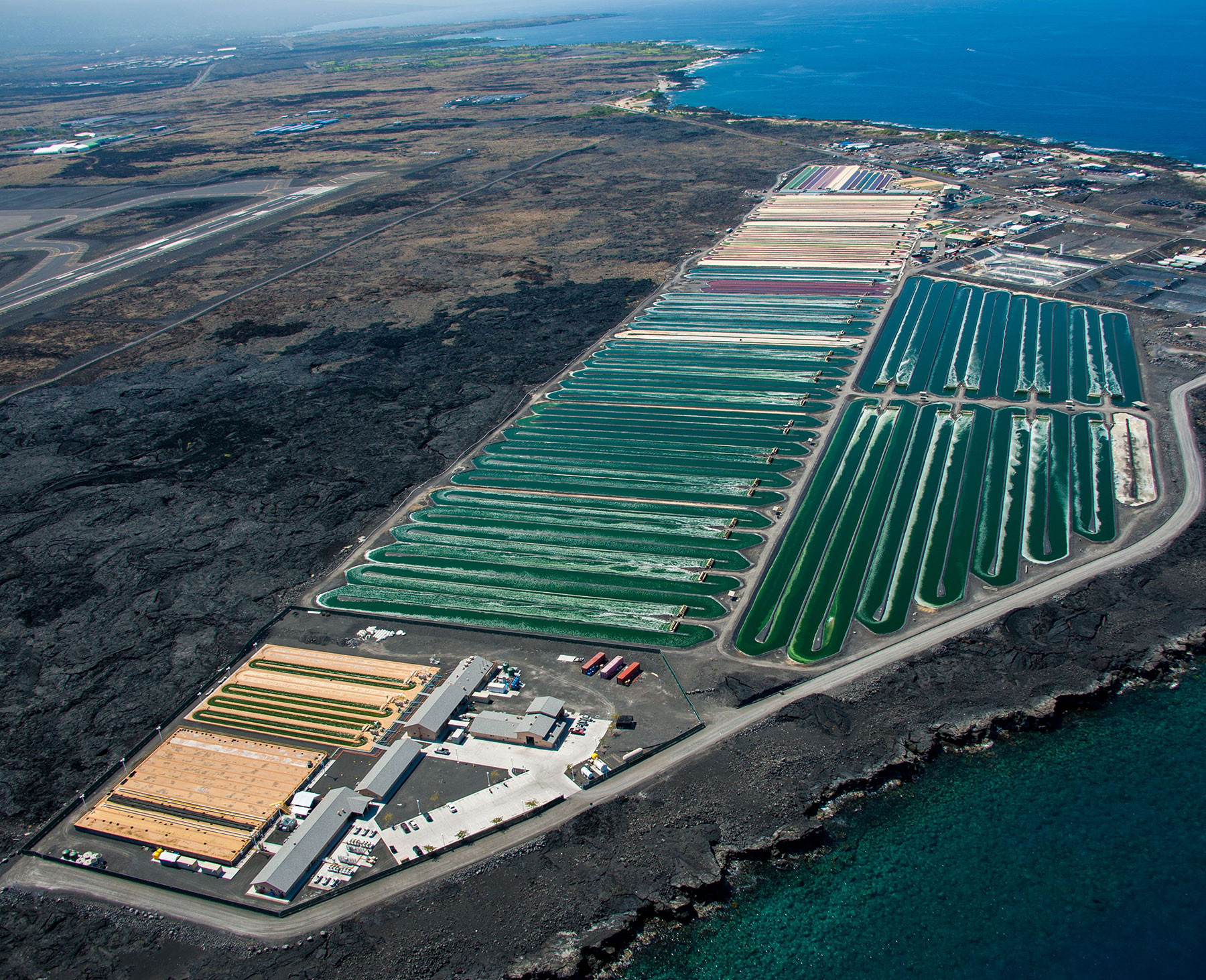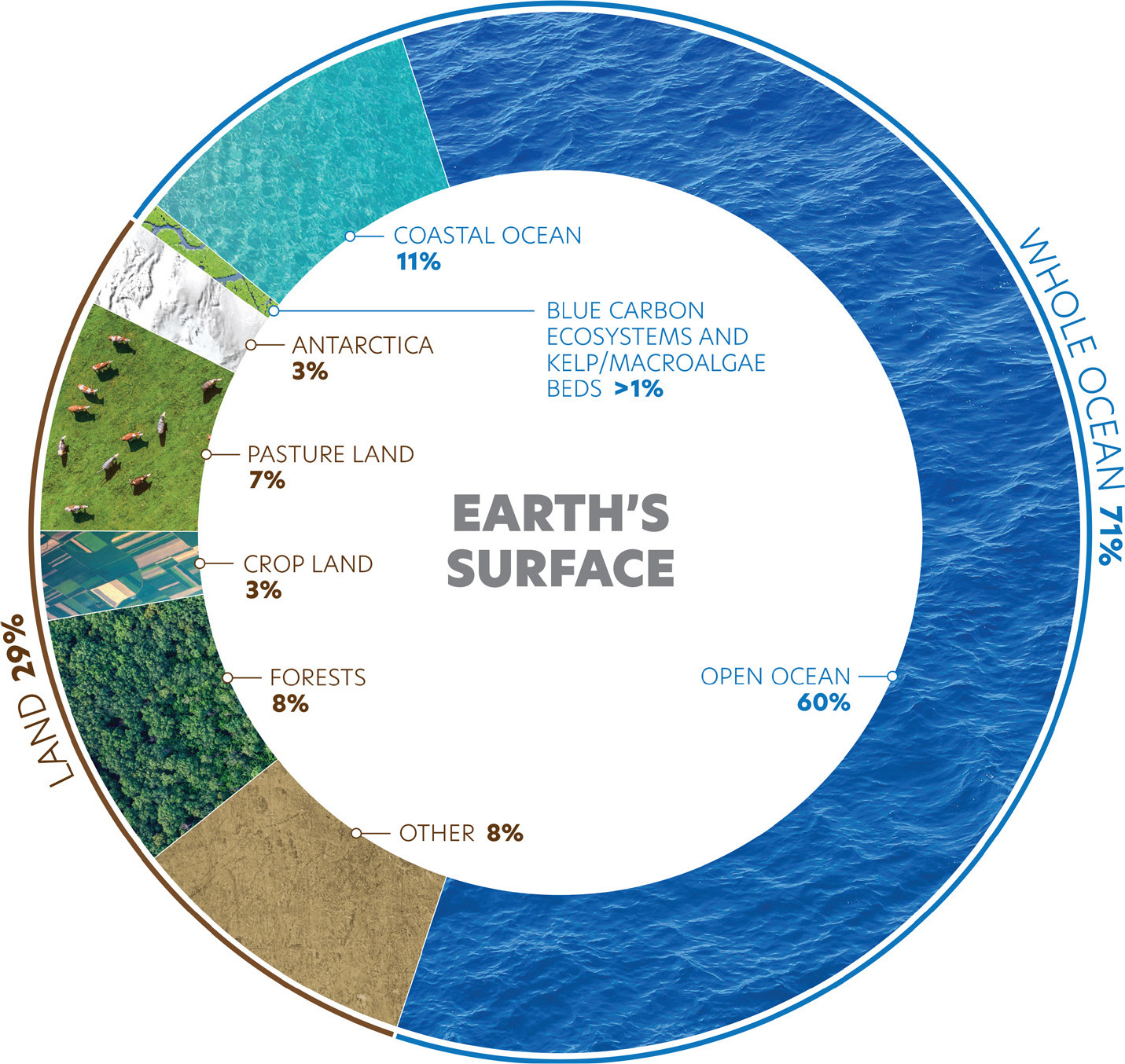Introduction
By 2050, the world’s population is projected to approach 10 billion people. It is projected that global food production will need to increase by up to 56% to meet the nutritional demands of this growing and increasingly affluent population (Figure 1; Godfray et al., 2010; World Resources Institute, 2019). Yet, even today’s food production is unsustainable and insufficient. On land, agriculture provides the backbone of the global food production system; however, its benefits come at the expense of negative impacts on land use and carbon emissions (Figure 1) as well as freshwater resources and biodiversity (Foley et al., 2005, 2011; Tilman et al., 2011; Conforti, 2011; Springmann et al., 2016; Ritchie and Roser, 2019; World Resources Institute, 2019; Zurek et al., 2022). If we look to the ocean for sources of nutrition, most wild-capture fisheries are already fully exploited or overexploited, and current marine aquaculture practices are insufficiently developed to close the gap between nutritional supply and demand (Cai and Leung, 2017; Naylor et al., 2021). In addition, both often pose environmental and social justice problems comparable to those of terrestrial agriculture (Moomaw et al., 2017; World Resources Institute, 2019; Bank et al., 2021).

FIGURE 1. Projected global population increase from 2010 to 2050 and the corresponding projected gaps in agricultural food production, land use, and climate mitigation. All projections are based on data reported in the World Resources Institute (2019) report. (a) The projected population increase is 3 billion people, a 43% increase. (b) The projected agricultural food gap, assuming a business-as-usual scenario and measured in energy required from all crops intended for direct human consumption, animal feed, industrial uses, seeds, and biofuels, is 7.4 trillion kilocalories, a 56% increase. (c) The projected agricultural land gap, assuming a business-as-usual scenario and measured in land area required to support all agricultural food production, is 0.4 billion ha of pastureland and 0.2 billion ha of cropland, a total 12% increase. Note the non-zero baseline in this panel. (d) The projected agricultural climate mitigation gaps are the differences between the projected level of greenhouse gas emissions in 2050 and the emission levels necessary to achieve the Intergovernmental Panel on Climate Change stabilized temperature increase targets of 1.5°C and 2.0°C. The projected increase in greenhouse gas emissions, assuming a business-as-usual scenario and measured in CO2 equivalents emitted from the food production process itself and land-use change, is 3 Gt CO2e, a 25% increase. > High res figure
|
Currently, it is estimated that one-quarter of the world’s population is malnourished, with two billion people consuming diets deficient in micronutrients and over 800 million people unable to secure enough calories to meet their minimum daily energy requirements (Moomaw et al., 2017; World Hunger and Poverty Facts and Statistics, 2018; Willett et al., 2019). Food distribution and waste are a significant part of the problem today; however, even improvements in those areas by 2050 will be inadequate to feed an additional three billion people, most of them populating developing countries (World Resources Institute, 2019). To secure an adequate food supply during the second half of the twenty-first century, society will need to significantly intensify the output of its food production system while simultaneously reducing its detrimental impacts on the global environment.
Given constraints on increasing agricultural output, many alternative food options are being explored to evaluate how society might sustainably intensify its food production system (Parodi et al., 2018; Duff et al., 2020). Among marine “blue food” options, aquaculture has attracted much attention, primarily because expansion of wild-capture fisheries will be unable to keep up with increasing demand (Cai and Leung, 2017; Costello et al., 2020). However, expansion of marine aquaculture as it is currently practiced also has finite limits. Belton et al. (2020) argue that the potential to intensify global food production through marine shellfish and finfish aquaculture is much more limited than its advocates claim. These authors conclude that the future of aquaculture is in freshwater finfish, and that society’s expectations of output from marine aquaculture sources should be lowered.
While Belton et al. (2020) highlight several important issues, we disagree with their primary conclusion on the limits of marine aquaculture. A recent review by Naylor et al. (2021) confirms the dominance of freshwater finfish production in the global aquaculture market: in 2017, it comprised 75% of the 112 Mt of live-weight volume produced. However, during the 20 years since a previous review by Naylor et al. (2000), marine algae-based aquaculture has grown rapidly, having produced 32 Mt in 2017, comparable to that of all aquaculture sectors in 1997 (34 Mt; Naylor et al., 2021). This rapid growth, primarily in the form of macroalgae, highlights the great potential of marine algae-based aquaculture for further expansion. In addition, although there has been some commercial development of microalgae in small-scale nutraceutical and niche food markets, there has been limited penetration into food, animal feed, and aquafeed commodity markets. Based on recent research (Gerber et al., 2016; Walsh et al., 2016; Moomaw et al., 2017; Beal et al., 2018a; Shah et al., 2018; Lei, 2021), we believe that there is considerable scope for growth in developing such microalgae-based nutritional commodity markets. Here, we explore the hypothesis that marine algae-based aquaculture has the potential to close the projected gap in humanity’s future nutritional demands and can do so while simultaneously reducing the detrimental climate and other environmental impacts of the current food production system.
A Circular Economy Approach
In October 2020, the Ocean Visions Consortium established the Marine Circular Bioeconomy (MCB) Task Force (https://oceanvisions.org/our-programs/marine-circular-bioeconomy/) to explore marine aquaculture’s potential for sustainably intensifying global food production. The MCB Task Force employs a circular economy approach (de Wit et al., 2020), which emphasizes reducing new resource extraction and increasing end-of-use processing and recycling. In contrast to the “take-make-waste” linear model, the circular economy model is regenerative by design, and aims to decouple economic development from finite resource extraction.
Applied to marine aquaculture (Figure 2), the circular economy approach allows tracking and quantification of energy inputs and the flows, recycling, and reuse of materials. It enables visualization of opportunities for reducing the consumption of new resources and, through recycling and reuse, the production of waste products. It also enables visualization of opportunities for combining processes in novel and more efficient ways to enhance the co-production of food and energy as well as the capture, storage, and utilization of carbon dioxide.
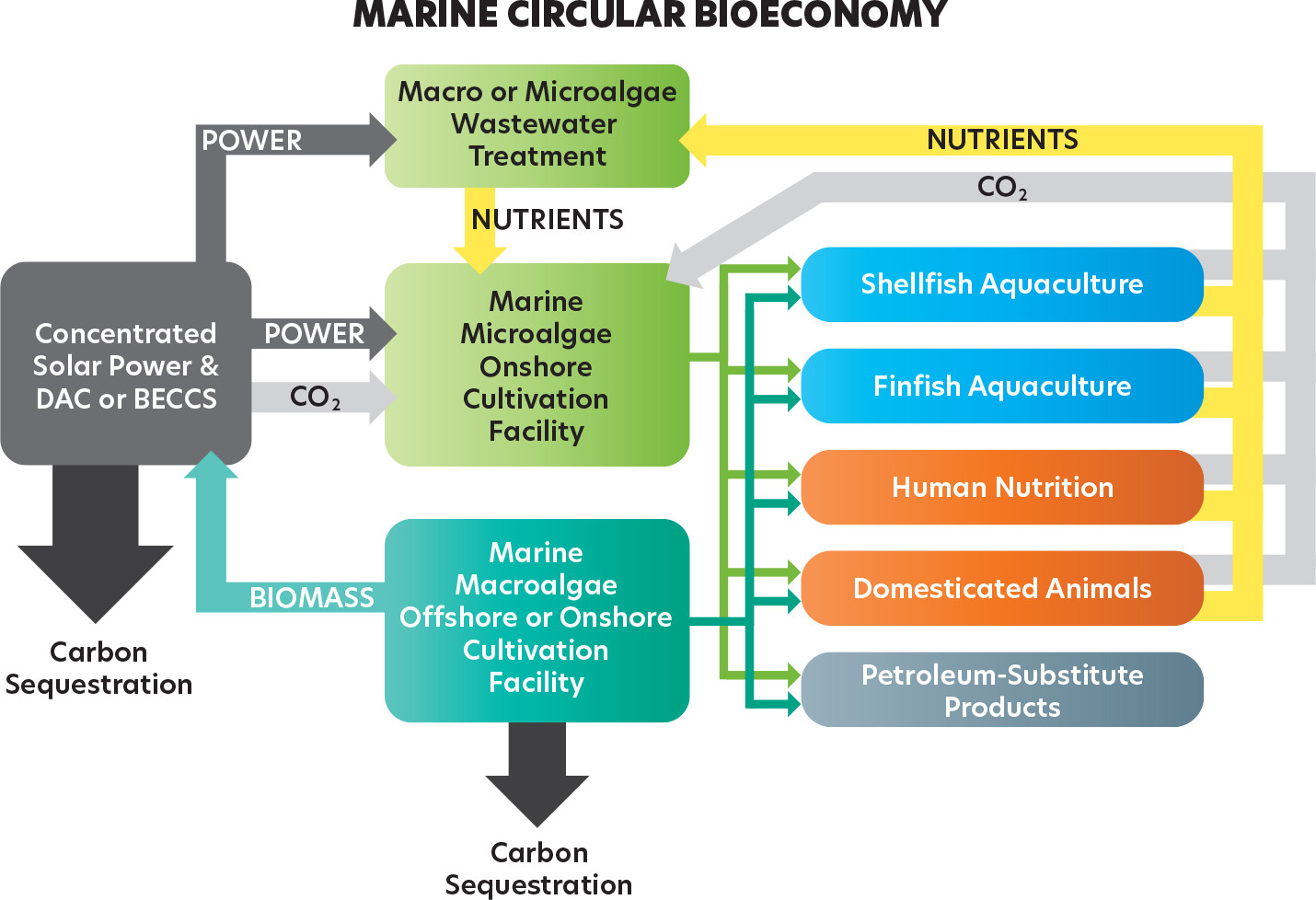
FIGURE 2. The Marine Circular Bioeconomy concept as applied to marine aquaculture. DAC = direct air capture. BECCS = bioenergy with carbon capture and storage. > High res figure
|
A Twenty-First Century Challenge: Expanding the Spatial Extent and Utilization of Blue Carbon
The ocean currently accounts for approximately half of Earth’s annual global primary production, ~50 Gt C yr–1 (Field et al., 1998; Boyd et al., 2014). In contrast to terrestrial primary production, very little of this autotrophic blue carbon makes its way into the human food production system. Most of the ocean’s primary production is carried out by small planktonic algae in the open ocean, where productivity per unit area is relatively low and food chains are relatively long (Ryther, 1969). Both factors set constraints on the potential contribution of open ocean ecosystems to human nutrition.
In contrast to the open ocean, coastal ocean ecosystems have much higher primary productivity per unit area and shorter food chains, especially in upwelling regions (Ryther, 1969). These factors account for coastal ocean ecosystems providing a vast majority of the world’s wild-capture fisheries harvest. In addition, the coastal ocean is home to benthic macroalgae beds and kelp forests as well as mangrove, salt marsh, and seagrass blue-carbon ecosystems. Despite their high productivity per unit area and large carbon storage capacity, these macroalgae and blue-carbon ecosystems occupy less than 1% of Earth’s surface area (Figure 3). Therefore, although they contribute a large fraction of the primary production in nearshore coastal environments (Macreadie et al., 2019), these ecosystems make relatively small contributions to the ocean’s total annual primary production and carbon sequestration (Nellemann et al., 2009; Scott-Buechler and Greene, 2019).
A primary challenge for marine algae-based aquaculture in the coming decades is to increase the amount of autotrophic blue carbon making its way into the human food production system. At present, most marine aquaculture is confined to the coastal ocean. Because the coastal ocean only makes up approximately 11% of Earth’s surface area (Figure 3), this places a fundamental constraint on the potential contribution of present-day marine aquaculture to human nutrition. This potential contribution is further constrained by the many other human activities in the coastal ocean that reduce the spatial area available to marine aquaculture.
One solution to this challenge is to increase the spatial extent of marine algae-based aquaculture. This can be done by expanding the footprint of marine aquaculture facilities both onshore and further offshore. In comparison to onshore micro- and macro-algae cultivation, the technological development of aquaculture facilities further offshore, into deeper oceanic waters, is less mature (Buck and Langan, 2017; Buck and Grote, 2018; Araújo et al., 2021). The main challenge to constructing such facilities is the need for new technologies that can withstand exposure to the greater hydrodynamic forces of the oceanic environment while not incurring capital and operational costs that are prohibitively expensive. Neither China, the global leader in marine macroalgae aquaculture, nor the European Union have made significant research and development investments in this area. Recent advances have been made in the United States through the ARPA-E Macroalgae Research Inspiring Novel Energy Resources (MARINER) program (https://arpa-e.energy.gov/technologies/programs/mariner). Nevertheless, sustained research and development, including the assessment of potential environmental impacts (Boyd et al., 2022), will be required to make offshore oceanic aquaculture commercially viable and globally scalable.
Nutritional and Sustainability Advantages of Marine Microalgae-Based Aquaculture
In contrast to offshore oceanic aquaculture, there is a rich, 50-year history of developing aquaculture facilities onshore for the cultivation of both freshwater and marine microalgae (Benemann, 2013; DOE, 2016a,b; Khan et al., 2018). Although the focus of microalgae-based aquaculture was originally on the production of biofuels and nutraceuticals, research in the field has evolved more recently to investigate the potential of microalgae for producing animal and aqua feeds as well as food for direct human consumption (Moomaw et al., 2017; Lei, 2021; Wang et al., 2021).
Food production from marine microalgae cultivated in onshore aquaculture facilities offers several nutritional and environmental sustainability advantages relative to terrestrial agriculture. As a polyphyletic group composed of thousands of different, mostly unstudied species, marine microalgae represent a potentially large, untapped source of high-quality nutritional protein. Although the range is large, many species possess a protein content greater than 40% dry mass (Wang et al., 2021). In addition, relative to terrestrial plants, marine microalgae provide a better source of essential amino acids and other micronutrients, such as vitamins, antioxidants, omega-3 polyunsaturated fatty acids, and minerals (Moomaw et al., 2017; Lei, 2021; Wang et al., 2021).
In terms of direct environmental sustainability advantages, microalgae exhibit primary production rates that are typically more than an order of magnitude greater than the most productive terrestrial crops (Huntley and Redalje, 2007). Thus, with regard to land use, the cultivation of marine microalgae in onshore aquaculture facilities has the potential to produce an equivalent amount of food from less than one-tenth the land area. In addition, because marine microalgae do not require soil and irrigation, their cultivation does not need to compete with agriculture and other stakeholders for arable land and freshwater (Figure 4; Greene et al., 2016; Walsh et al., 2016; Moomaw et al., 2017). Lastly, because the cultivation of marine microalgae is very efficient in its use of nutrients, only losing those nutrients that are harvested in the desired products, the problems associated with excess fertilizer runoff and subsequent eutrophication of aquatic and marine ecosystems can be minimized. Results from a few simple calculations are presented in Box 1A to put these direct environmental sustainability advantages into perspective quantitatively.
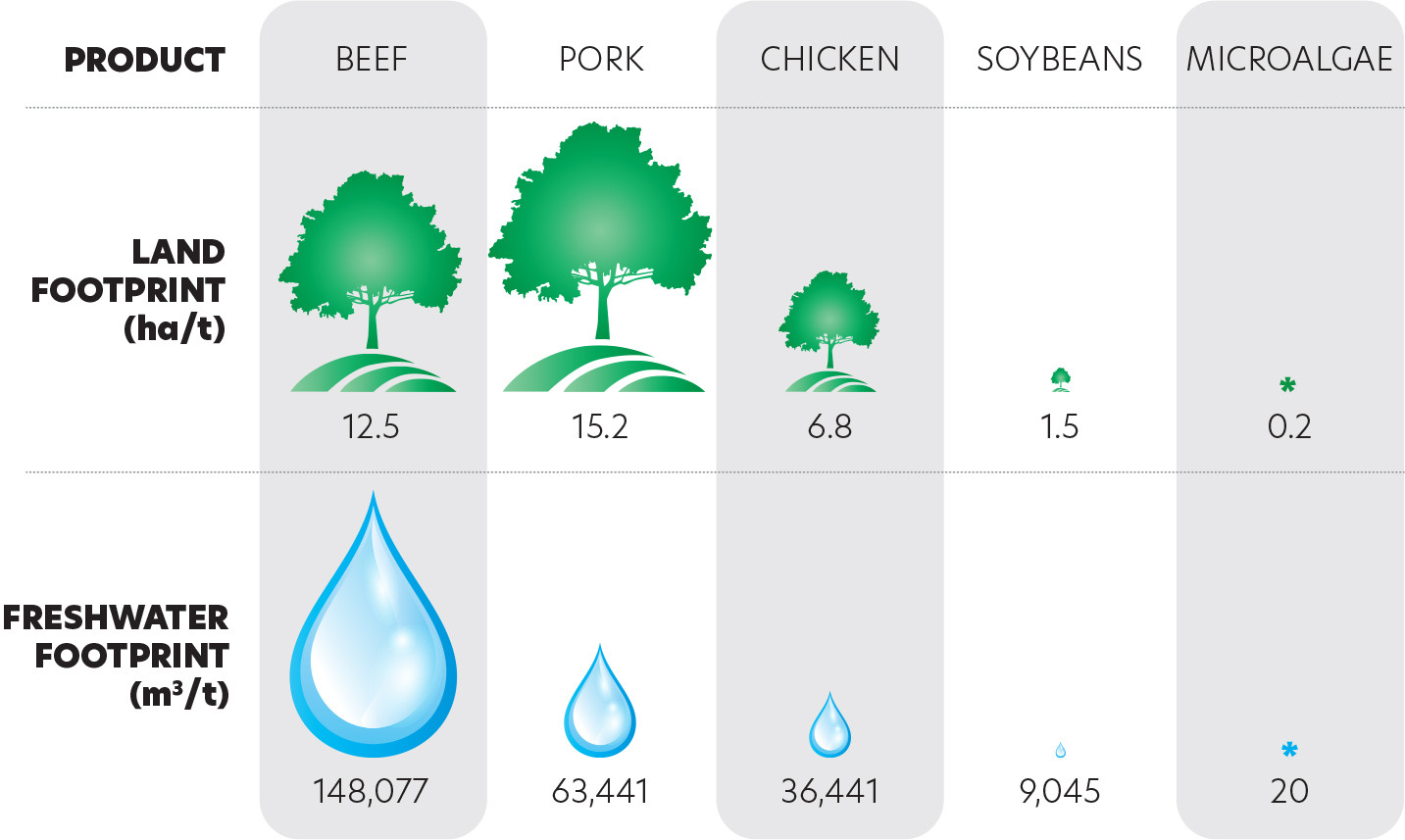
FIGURE 4. The land and freshwater footprints for the production of essential amino acids from various nutritional sources. All estimates are based on data reported by Moomaw et al. (2017). Land footprints are reported in hectares per metric ton of product. Freshwater footprints are reported in cubic meters of freshwater per metric ton of product. > High res figure
|
The potential for less direct environmental sustainability advantages should also be noted. By reducing agriculture’s demand for arable land, the cultivation of marine microalgae has the potential to markedly reduce greenhouse gas emissions and biodiversity loss. For example, over the past 50 years, approximately one-fifth of the Amazonian rainforest has been cleared, mostly for cattle pastureland and soy cropland (Krogh, 2020). This deforestation has been so extensive that the Amazon has recently transitioned from being a globally important carbon sink to a net carbon source (Gatti et al., 2021). In addition, there is growing concern that further interactions between deforestation and climate change may force the Amazonian rainforest to cross a tipping point that will jeopardize the greater than 120 Gt of carbon stored in its above- and below-ground biomass (Boulton et al., 2022) as well as its remarkable biodiversity. Results from a few simple calculations are presented in Box 1B to demonstrate marine microalgae’s potential for reducing the pressure to clear Amazonian rainforest for cattle pastureland and soy cropland.
Box 1. Environmental Sustainability Advantages of Marine Microalgae-Based Aquaculture*
A. Examples of Direct Environmental Sustainability Advantages
The 2020 global production of soybeans was 353 Mt/yr from a harvestable cropland area of 1.3 million km2 (FAO, 2021). Assuming a 13% protein content in wet weight biomass (USDA, 2018), this converts to a 2020 global soy protein production of 46 Mt/yr. Assuming an algal protein productivity value of 3.36 × 10–3 Mt/km2/yr (Huntley et al., 2015; DOE, 2016b; Wang et al., 2021), the microalgae cultivation area required to produce a similar amount of protein would be approximately 13,700 km2, saving 95 times as much cropland.
Assuming a globally averaged, blue-water irrigation demand for soybean production of 123,000 m3/km2/yr, the amount of freshwater saved annually could approach 160 billion cubic meters. This is comparable to the current annual blue-water irrigation demand of the United States for all crops (FAO, 2022).
Assuming that soybean production requires 5.5 t/km2/yr of phosphate fertilizer and that 2.3% of this fertilizer runs off (Alexander et al., 2008), then the amount of phosphate saved from fertilizer runoff annually would be ~164,000 t. This corresponds to ~3.2% of the annual North American phosphate fertilizer demand (FAO, 2019).
B. Examples of Less Direct Environmental Sustainability Advantages
The 2020 production of soybeans in Brazil was 128 Mt/yr from a harvestable area of 372,000 km2 (FAO, 2021). Assuming a 13% protein content in wet weight biomass (USDA, 2018), this converts to a Brazilian soy protein production of 16.6 Mt/yr. Assuming an algal protein productivity value of 3.36 × 10–3 Mt/km2/yr, the microalgae cultivation area required to produce a similar amount of protein would be approximately 4,940 km2, providing a potential savings of 75 times as much cropland.
The average 2018–2020 production of beef (equivalent carcass weight) in Brazil was 10.0 Mt/yr from a grazing area of 1.65 million km2 (FAO, 2021). Assuming a 15% protein content in equivalent carcass weight, this converts to a Brazilian beef protein production of 1.5 Mt/yr. Assuming an algal protein productivity value of 3.36 × 10–3 Mt/km2/yr, the microalgae cultivation area required to produce a similar amount of protein would be approximately 446 km2, providing a potential savings of 3,700 times as much pastureland.
Note that complete replacement of Brazilian soy and beef protein with marine microalgae protein is unlikely and not being suggested here. On the other hand, Amazonian biodiversity accounts for over one-quarter of all terrestrial animal and plant species on Earth (Dirzo and Raven, 2003), and a recent study by Allan et al. (2022) determined that 49.3% of Brazil’s 4,206,016 km2 of land area requires some level of conservation attention. By reducing the demand for cropland and pastureland in Brazil, the cultivation of marine microalgae could have a significant impact on the conservation of Amazonian biodiversity. Brazil possesses enough suitable land along its coastline to produce globally significant amounts of marine microalgae protein (Figure 5).
*See the online Supplementary Materials for calculations regarding the productions and demands presented here.
|
Sustainability Challenges for Marine Microalgae-Based Aquaculture
While the potential environmental sustainability advantages of marine microalgae-based aquaculture are great, the challenges of scaling it up globally are also significant. Although there are large areas of suitable land with proper topography and insolation available in the tropics and subtropics, cultivation facilities must be close enough to sources of seawater or brackish water to avoid excessive transport costs (Figure 5).
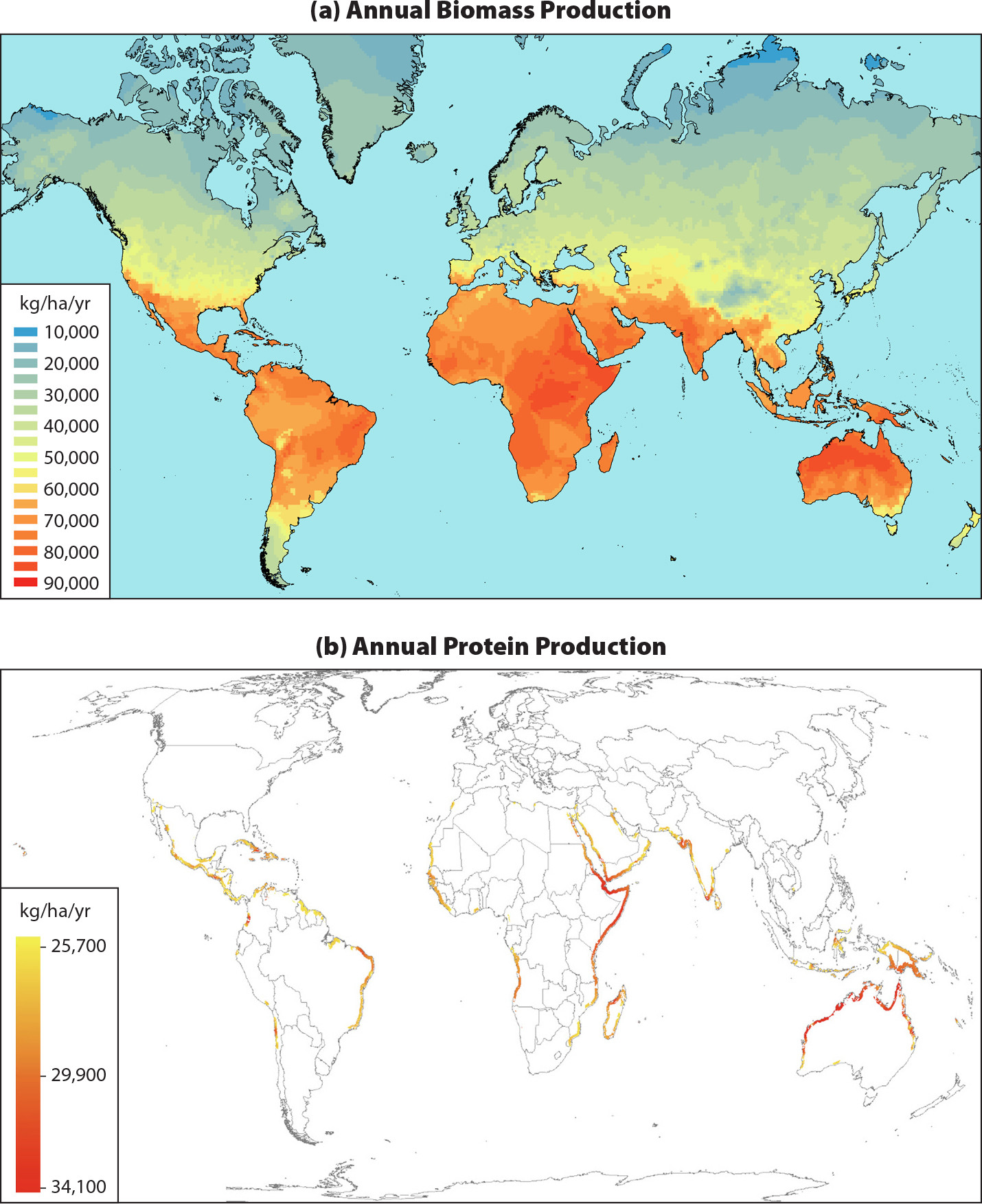
FIGURE 5. (a) Global map of potential onshore marine microalgae biomass production based on annual incoming solar radiation data and a validated growth model. (b) Global map of potential onshore marine microalgae protein production with constraints set by additional environmental criteria, including topography and access to seawater (see Supplementary Materials). > High res figure
|
More challenging than finding suitable land is the requirement for carbon dioxide. When growing rapidly, microalgae take up carbon dioxide faster than it can diffuse across the air-water interface of open cultivation ponds. Carbon dioxide must be added to the ponds, and the costs of supplying this gas, both energetic and financial, must be kept low. Ideally, carbon dioxide should be produced on site from non-fossil carbon sources. Several authors have suggested this could be achieved by integrating microalgae cultivation facilities with direct air capture (DAC; Greene et al., 2016, 2017; Wilcox et al., 2017) or bioenergy with carbon capture and storage (BECCS; Beal et al., 2018b) technologies. Current DAC approaches are prohibitively expensive for this purpose; however, integrating DAC with concentrated solar power or other emerging renewable energy technologies could provide a cost-effective approach for simultaneously generating power and capturing carbon dioxide (Greene et al., 2017; Baker et al., 2020).
Providing nutrients for cultivating marine microalgae on a global scale also presents a formidable challenge, especially with regard to phosphorus. The scientific community has spent just over a decade trying to predict when global agriculture will become constrained by “peak phosphorus” (Cordell et al., 2009), and microalgae cultivation will not be immune to such a constraint. In fact, the stoichiometric nutrient requirements for microalgae amplify this phosphorus challenge (Lenton, 2014). Fortunately, the efficiency of nutrient use mentioned previously (i.e., no fertilizer runoff) combined with the potential for nutrient recycling through algae-based wastewater treatment make the challenge less daunting. Recovering and reusing phosphorus from waste streams is the kind of challenge that the circular economy approach is well positioned to tackle (Ullmann and Grimm, 2021).
Food for Thought
A global analysis of coastal areas suitable for marine microalgae-based aquaculture reveals that, even with conservative assumptions, this untapped sector of the global food production system has the potential to provide greater than 100% of global protein demand for 2050 (see Supplementary Materials). However, all areas of the world are not created equal when it comes to the geophysical requirement for cultivating marine microalgae (Figure 5). Our analysis reveals that much of this sector’s potential lies in the Global South.1 While vast continental areas of Eurasia and North America have traditionally been viewed as society’s global breadbaskets, marine microalgae-based aquaculture provides an opportunity to better balance food production between the two socioeconomic hemispheres.
Geophysical considerations are necessary, but they are not sufficient to ensure the expansion of marine microalgae-based aquaculture in the Global South. Financial considerations must also be weighed. Fortunately, land and labor costs are relatively inexpensive in the Global South, and they will provide further incentives for development. Perhaps the most important financial incentive, however, is the Green Climate Fund. Formally adopted during the 2011 United Nations Climate Change Conference (COP 17) in Durban, South Africa, the Green Climate Fund was originally conceived as a mechanism for wealthier countries to assist developing countries in their efforts to mitigate and adapt to the effects of climate change. Implementation of the Green Climate Fund has been difficult because the incentives for wealthier countries to contribute have been modest, especially with regard to adaptation measures. However, marine microalgae-based aquaculture can offer mutually beneficial investment opportunities for both wealthy and developing countries by providing climate mitigation while simultaneously enhancing global food and water security.
Acknowledgments
The authors of this paper acknowledge research support from US Department of Energy Award Nos. DE-EE000791, DE-EE0008518, and DE-EE0009278 to Duke University and US Department of Energy Award No. DE-EE0007091 to the Duke Marine Algae Industrialization Consortium (MAGIC) and US Department of Agriculture/National Institute of Food and Agriculture/Sustainable Agricultural Systems Award No. 2019-69012-29905 to the University of Arkansas and Cornell University. The Marine Circular Bioeconomy workshop was supported by ARPA-E Award No. DE-AR0001520 to the University of Washington’s Friday Harbor Laboratories. CSB received additional support through a Knauss Fellowship from the National Oceanic and Atmospheric Administration and an internship with the Ocean Visions Consortium. AH received additional support through an internship with Impossible Foods.

